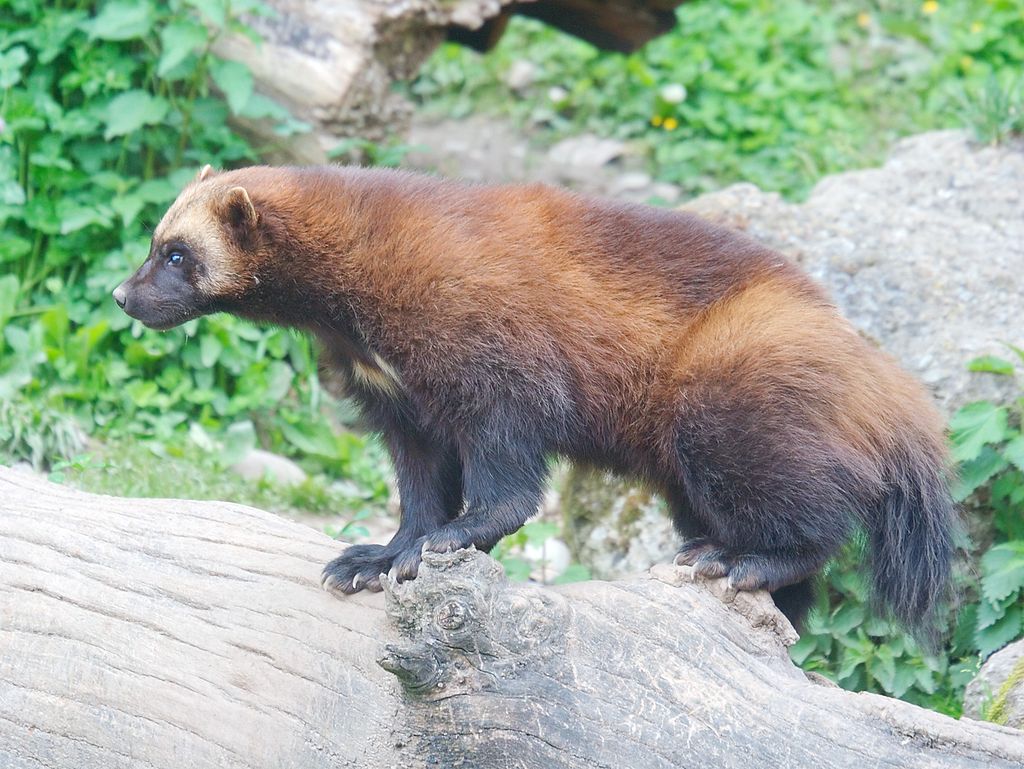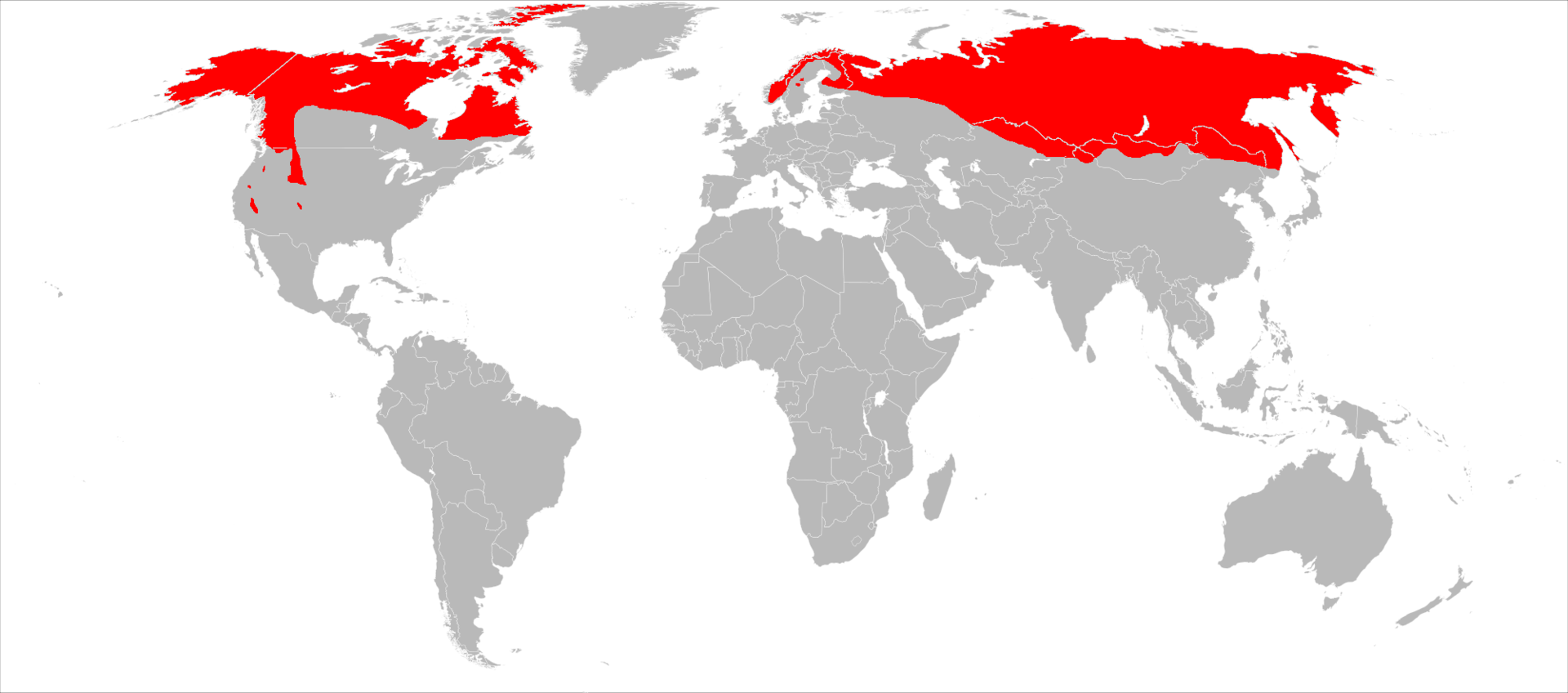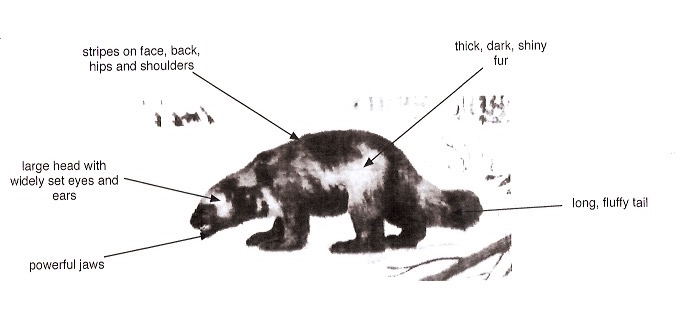Wolverine
Introduction The wolverine is climbing a tree trunk.WolverineWolverine are the biggest mustelidmustelid in the world. Weasels, ottersotters and stoats are its cousins.cousins. They are found in many places aroundaround the world. SometimesSometimes people call it a skunk bear because it looks a little bit like a small bear and smells bad like a skunk. Its scientificscientific name is gulo gulo which means glutton.
The wolverine is climbing a tree trunk.WolverineWolverine are the biggest mustelidmustelid in the world. Weasels, ottersotters and stoats are its cousins.cousins. They are found in many places aroundaround the world. SometimesSometimes people call it a skunk bear because it looks a little bit like a small bear and smells bad like a skunk. Its scientificscientific name is gulo gulo which means glutton.
Where They Live
World Map of Wolverine Distribution Wolverine live in birch forests and in mountains in North America and Europe. In these cold places, they dig long tunnelstunnels to snow caves and they take over old dens that bears have vacated.
Wolverine live in birch forests and in mountains in North America and Europe. In these cold places, they dig long tunnelstunnels to snow caves and they take over old dens that bears have vacated.
What They Look Like
Diagram of a Wolverine Wolverine can weigh 25 kilograms.kilograms. They can alsoalso be 90 centimetrescentimetres long and 43 centimetres tall, makemaking them about the size of a big dog. Their long fluffyfluffy tails are about 25 centimetres in length. On their bodybodies they have shine,shiny thick, dark fur with lighterlighter patches,patches, to protectprotect them from the cold. Stripes decoratedecorate their face, back, hips and shoulders.shoulders. Wolverines have large heads with small widelywidely set ears and eyes and powerfulpowerful jaws. To catch prey, they have a very good sense of smell and hearinghearing but not very good eyesight.
Wolverine can weigh 25 kilograms.kilograms. They can alsoalso be 90 centimetrescentimetres long and 43 centimetres tall, makemaking them about the size of a big dog. Their long fluffyfluffy tails are about 25 centimetres in length. On their bodybodies they have shine,shiny thick, dark fur with lighterlighter patches,patches, to protectprotect them from the cold. Stripes decoratedecorate their face, back, hips and shoulders.shoulders. Wolverines have large heads with small widelywidely set ears and eyes and powerfulpowerful jaws. To catch prey, they have a very good sense of smell and hearinghearing but not very good eyesight.
What They Eat
Sharp teeth with crushingcrushing molarsmolars help wolverine cut and rip open their prey.
| Fact Box |
|
Wolverine can eat frozen meat using their strong teeth and powerful jaws.
|
HuntingHunting alone,alone, they catch and eat mice, rabbits,rabbits, hares, marmots,marmots, squirrels,squirrels, birds, sheep, goats, reindeer,reindeer, and the biggestbiggest of all, moose! In winterwinter they scavengescavenge for food more because there is less prey availableavailable in the ArcticArctic Circle.
How They Move
To dig tunnelstunnels in the snow and climb trees, wolverine use their powerful legs and sharp claws. Their attackattack mode is to jump on their prey’s back and hold on tightlytightly untiluntil the animal falls, especiallyespecially for biggerbigger animals like reindeer and moose.
Life Cycle
Wolverine make their dens by diggingdigging tunnels in the snow, although they do notdon’t hibernate.hibernate. In their dens the females wait for 50 days until they have 2 to 3 babybabies (kits) in February, in the winter. When they are born they are white and they are weaneded after 70 days (10 weeks) when they leave their den. Wolverine are solitarysolitary tough animals that travel great distancesdistances high up in the tiagatiaga and tundratundra to find food.
Danger
For wolverine, their main enemyenemy is people, larger predatorspredators and their tough habitathabitat in the snow and ice.
Conclusion
Wolverine look like giant ferrets but I would notwouldn’t want one as a pet. If they eat a reindeer, they can eat me! Their large paws are like show shoes and their claws are like cramponscrampons but I would notwouldn’t want to go trekkingtrekking through the snow with them. Finally,Finally, they are beauty,beautiful solitary carnivores but they still spend time with their babies in their dens.
Glossary
| Arctic Circle | imaginary circle around the North Pole | mustelids | the family that weasels, otters, stoats and wolverine belong to |
| birch | trees in the stunted forests of the tiaga | scavenge | eating dead animals |
| carnivores | meat eaters | solitary | being alone |
| crampons | spikes on a boot for walking in snow or ice | tiaga | stunted forests in the Arctic region below the tundra |
| glutton | greedy person or animal | tundra | treeless flat Arctic region where subsoil is permanently frozen |
| hibernate | sleep through the winter | vacated | lived in and left |
| molars | back teeth | weaned | no longer drinking mother's milk |
Bibliography
Mrs Nunweek's Fact File
By Ben
Photograph by Matthias Kabel
{chronoconnectivity5}L2L_NF2_Feedback{/chronoconnectivity5}